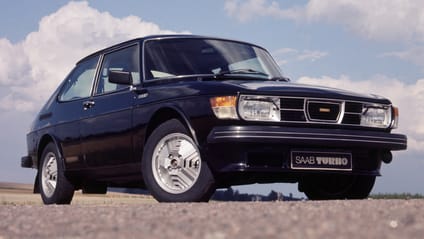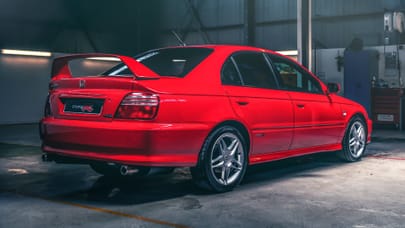
The beginner's guide to Saab
From greatest hits to lowest moments, everything you ever wanted to know... and a fair bit you didn’t

What’s Saab and when did it start making cars?

Saab Automobile was started in 1945 by Svenska Aeroplan Aktiebolaget (Swedish Aeroplane Corporation), or Saab. With plane demand tailing off after World War Two, Saab diversified into cars, its first model – the 92 – arriving in December 1949. Initial cars were all green as there was a job lot of camo paint left over.
Saab merged with truck maker Scania in 1969 and came under the authority of Sweden’s powerful, filthy rich Wallenberg dynasty. A deal with Fiat saw a lot of rebadging activity in the Seventies, but the firm’s iconic 900 model arrived in 1978 – over a million of them would end up getting built.
Saab was separated off in 1989, 50 per cent each for General Motors and the Wallenbergs, then GM bought the lot in 2000. This era meant sharing bits with Vauxhalls, but GM never got to grips with its Swedish offshoot and the company went into administration in 2009. Koenigsegg stepped in, but the deal fell through. Saab was sold to Dutch sports car outfit Spyker in 2010, then Chinese and Russian investors got involved and GM refused to continue providing its engineering. Saab died in 2014, and despite the efforts of a Chinese consortium in the late 2010s, remains firmly expired.
Advertisement - Page continues belowWhat’s the cheapest car that Saab builds... and what’s the most expensive?

Sadly you can’t buy yourself a new Saab anywhere, what with the company having gone out of business a decade ago, but a quick look on car buying website Auto Trader sees some very nice 9-3 convertibles for sale around the £500 mark. You can’t expect anything too fancy, though, and also don’t expect to find too many parts around these days unless you’re prepared to root around in scrapyards. A 150,000-mile model from 2002 in black caught our eye in Manchester, although the advert does say that the clutch is slipping.
The most expensive Saab we spotted was a punchy £39,995 1980 Saab 99 Turbo with a mere 14,000 miles on the clock. Though you would have to add a few driving it home from Saab specialist Hagstrom in Norfolk. The outfit says that the 2.0-litre manual is the “best for sale in the UK”, but then that’s probably what it tells all the girls.
What is Saab’s fastest car?

The fastest Saab still in production is the JAS 39 Gripen, with a top speed of around 1,200mph, but you’d be right to point out that it’s not a car. The 1999 9-3 Viggen was a souped up limited run version of Saab’s small hatchback, fitted with a 2.3-litre turbocharged petrol producing a heady 230bhp. The name came from Saab’s 37 Viggen jet fighter.
The 9-3 did get some jet-inspired upgrades, like the Nimonic alloy used on the exhaust valves, notable for its heat resistance. The car also benefitted from a larger intercooler, upgraded brakes, a new performance ECU and a massive turbo. The result was a 155mph top speed and 0–60mph in 6.5secs – perky performance figures, but still with Saab’s reputation for front-drive spikiness. Some hailed the Viggen as the last true great Saab, while others criticised its horrendous torque steer. Are those two things incompatible?
Advertisement - Page continues belowWhere are Saabs built and how many are sold a year?

Saab’s dead, baby, Saab’s dead. But when it was still going, it built its cars almost exclusively at its Trollhättan facility in central Sweden. It was built on top of Trollhättan airfield by Saab’s plane-producing parent company back in 1947, but quickly switched to making the new 92 model in 1949.
Chinese syndicate NEVS had grand plans to build electric Saabs at the Trollhättan facility, but that dream finally died when its main backer Evergrande went bankrupt in 2023. Saabs were also occasionally built in Finland by contract manufacturer Valmet, in Austria by Magna Steyr and in Ohio by General Motors if it happened to be a rebadged Chevrolet Trailblazer like the 9-7X of the mid-Noughties.
What’s the best concept that Saab ever made?

Saab has made some top concept cars over the years – the Catharina sports car in 1964, the 98 prototype in 1974, or the Aero-X in 2006 that gave us false hope (boo). The latter would be the first choice for many, but ultimately there’s no better Saab concept than the one that started it all, the aero-tastic Ursaab of 1946.
The teeny little 800kg coupe had a two-stroke engine and a slippery 0.3 drag coefficient. It was built by a team of plane engineers who had never worked on cars before – they scavenged rivals from scrapyards and tested the car at night. The Saab 92 was very different in production, but the original Saab was the coolest.
What was Saab’s best moment?

Saab was long a company of automotive industry firsts, and not just with the heated seats. In 1978 it became the first carmaker to mass produce turbocharged engines and that changed the world.
One quirky Saab feature came along in 1993 and became synonymous with the company’s cars – the night panel. Another bit of fighter jet inspiration, at the touch of a button all the lights inside the car would turn off apart from the speedo in the instrument panel, aiding night vision.
Or perhaps some of Saab’s flirtations with cinematic roles could be considered the company’s best moments – Paul Giamatti’s 900 convertible in 2004 wine-themed roadtrip movie Sideways, or Colin Firth shuttling his Portuguese maid about in a... 900. For a long time the best way to make a statement about your film character’s blandly non-comformist tendencies was to stick them in a 900, possibly wearing a rollneck sweater.
What was Saab’s worst moment?

Some might argue that getting snapped up by General Motors was Saab’s worst moment, but the plucky Swedish outfit was never going to last long without some serious support from a global carmaker. Sadly that ultimately meant Vectra underpinnings, a rebadged Chevrolet SUV and weirdly a reskinned Subaru Impreza estate that was hawked in the US for a few years.
The company’s long, slow decline was truly painful to watch, mirroring the same downfall of the once great Rover in the UK not very long before – an initial unsightly surprise collapse followed by prolonged squabbling over the remains.
Sadly for Saab, and unlike Rover, by the time it reached this point there was no meat left on the bones. Where Jaguar, Land Rover and Mini went on to flourish, Saab met its undignified end.
Advertisement - Page continues belowWhat was Saab’s biggest surprise?

If you were a journalist turning up for the 9-5 estate launch in 2000, the event would have no doubt been something of a surprise to you compared with some of the usual fare – it took place at an airstrip in New Mexico in the US at an elevation of 2,650 metres (two Ben Nevises) in order to show off the benefits of the car’s turbocharged engine at altitude (turbos are less affected by the lower air pressure the higher you go. Very handy if you live up two Ben Nevises).
Another 9-5-shaped surprise was the arrival of the second generation of the saloon in 2009 – for a company that was in the very visible process of trying to rinse as much cash as it could out of an aging lineup, it was actually a decent enough car. But was it sufficient to save the company? Well let’s not go crazy here (and the results are long evident), but it was a hopeful sign the company could’ve flourished in an alternate universe.
Trending this week
- Car Review
BMW iX3







